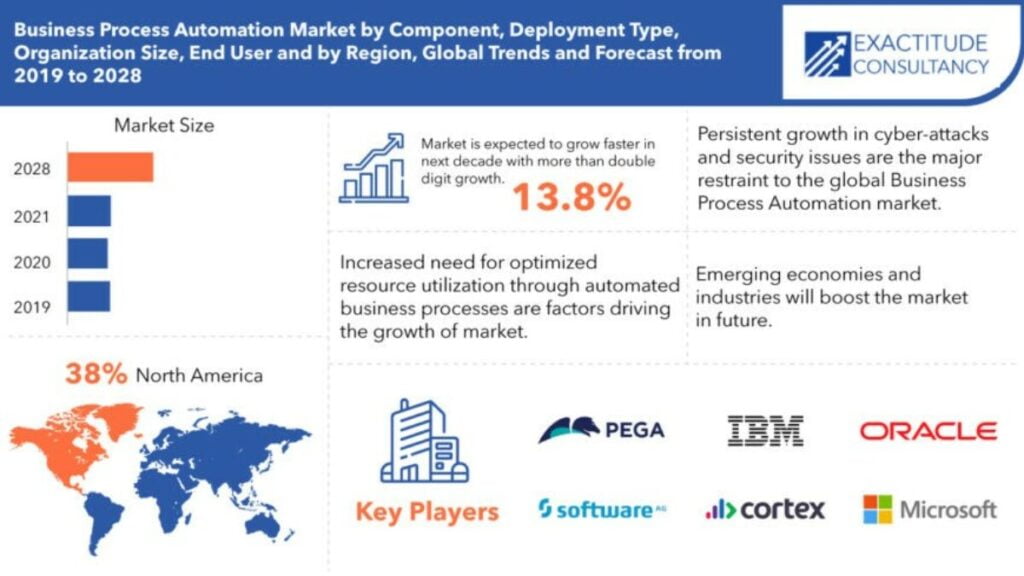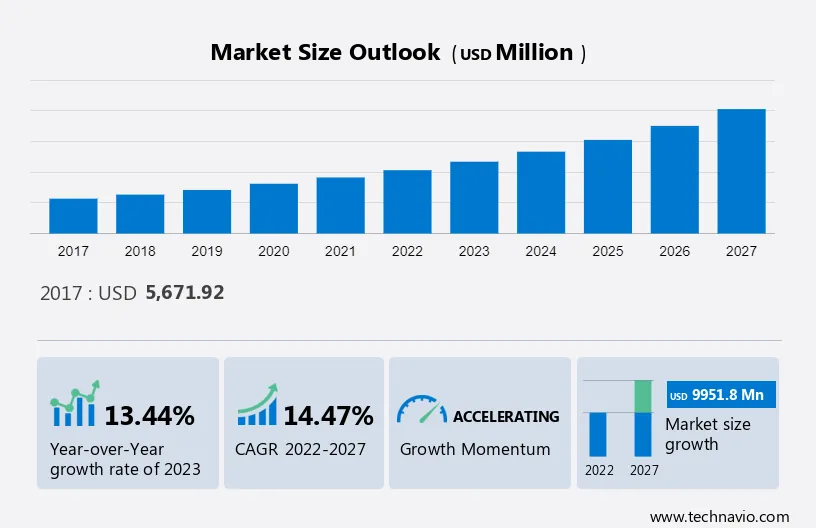As we’re aware that the need for efficiency and agility has never been more pronounced. To thrive in 2024 and beyond, companies must find innovative ways to streamline operations and maximize productivity. Enter Business Process Automation (BPA), a game-changing strategy that promises to revolutionize how businesses function.
In this comprehensive guide, we will delve into the world of BPA, its benefits, implementation strategies, and trends for 2024. Scroll down to learn more…!!!
What is Business Process Automation (BPA)?
BPA is the use of technology to automate routine, repetitive tasks and processes within an organization. These tasks can span various departments, from HR and finance to customer service and marketing. The goal is simple: to free up valuable human resources from time-consuming, manual work, and allow them to focus on more strategic, creative, and value-added activities.
Imagine a world where data entry, document approvals, and inventory management happen seamlessly, without the need for human intervention. Business process & tech can make this a reality.
Business Process Automation Examples
Here are some concrete examples of BPA across different industries:
Finance and Accounting
- Automatic invoice processing: Using OCR technology to extract data from invoices and automatically generate payments, saving time and reducing errors.
- Expense report processing: Employees submit expenses electronically, and the system automatically verifies them for compliance and approval.
- Reconciliation and reporting: Automated reconciliation of bank statements and other financial data, with reports generated automatically for faster insights.
Human Resources
- Onboarding new employees: Streamlining the process with automated tasks like sending welcome emails, setting up accounts, and providing training materials.
- Payroll and benefits administration: Automating payroll calculations, tax deductions, and benefit enrollments, ensuring accuracy and reducing manual workload.
- Performance management: Automated performance reviews with pre-set metrics and feedback loops, providing employees with real-time feedback and improving communication.
Marketing and Sales
- Lead generation and qualification: Automating lead capture forms, scoring leads based on criteria, and routing them to the right sales representatives.
- Social media management: Scheduling and publishing social media posts in advance, responding to comments and messages automatically, and analyzing campaign performance.
- Customer relationship management (CRM): Automating tasks like sending targeted email campaigns, tracking customer interactions, and generating reports for sales and marketing teams.
Operations and Supply Chain
- Order fulfillment: Automating order processing, inventory management, and shipping logistics for faster and more efficient delivery.
- Inventory control: Monitoring inventory levels, setting reorder points, and generating purchase orders automatically to prevent stockouts.
- Quality control: Implementing automated quality checks on production lines, identifying defects early, and preventing costly rework.
Healthcare
- Patient scheduling and appointment reminders: Automating appointment booking, sending reminders, and managing waitlists.
- Prescription management: Automating prescription refills, ensuring medication adherence, and reducing medication errors.
- Claims processing: Automating the submission and processing of insurance claims, improving efficiency and reducing administrative costs.
Why Businesses Should Process Automation?
It has several benefits that cannot be ignored by businesses. Below are the reasons why business process automation is crucial to staying ahead of the competition.
Boosted Efficiency: The most immediate benefit of BPA is the significant increase in efficiency. Tasks that once took hours or even days to complete can now be done in a matter of minutes. This not only saves time but also reduces the risk of errors associated with manual processes.
Cost Savings: By automating repetitive tasks, businesses can significantly reduce operational costs. Fewer manual labor hours mean lower labor costs, fewer errors requiring rectification, and reduced overhead.
Improved Accuracy: Human error is inevitable, but with BPA, the margin for error shrinks dramatically. Automated processes follow predefined rules and guidelines consistently, ensuring accuracy and reliability.
Enhanced Customer Experience: Business process automation technologies allow companies to provide faster, more efficient service to customers. From quicker response times to personalized experiences, automation can lead to higher customer satisfaction and retention.
Scalability: As businesses grow, so do their processes and workflows. Business process scales seamlessly, accommodating increased workload and complexity without requiring a proportional increase in resources.
Strategic Focus: With routine tasks automated, employees can dedicate their time and expertise to strategic activities that drive innovation and growth. This shift in focus can lead to breakthroughs and a competitive edge.
How you should Process Business Automation for Success?
Implementing BPA may seem like a daunting task, but with the right approach, it can be a smooth transition. Here’s a step-by-step guide by a business process expert to help you get started:
- Identify Processes to Automate
First and foremost, begin by identifying processes that are repetitive, rule-based, and time-consuming. These are prime candidates for automation. Common examples include data entry, invoice processing, and employee on boarding.
- Set Clear Objectives
Secondly, define what you aim to achieve with automation. Is it reducing processing time, cutting costs, or improving accuracy? Having clear objectives will guide your BPA strategy.
- Choose the Right BPA Tools
Next, selecting the appropriate technology is crucial. Depending on your needs, this could involve Robotic Process Automation (RPA) software, workflow management systems, or Artificial Intelligence (AI) solutions.
- Develop a Strategy
Map out the entire automation process, from start to finish. Ensure that it aligns with your business goals and integrates seamlessly with existing systems.
- Pilot Testing
Before full-scale implementation, conduct pilot tests to identify any potential issues and fine-tune the automation process.
- Train Your Team
Equip your employees with the necessary skills to work alongside automated processes. Training ensures a smooth transition and encourages buy-in from your workforce.
- Monitor and Optimize
Lastly, continuous monitoring is crucial to ensure that your automated processes are delivering the expected results. You can make adjustments as needed to optimize performance.
In addition, to make such tasks easier and more effortless, contacting an honest business process outsourcing service provider can be the best option to become a quick game-changer. Next, we shall move to the important aspect of the business process.
Advantages of Employing Business Process Automation Tools
Increased Efficiency: Automation tools streamline workflows, reducing manual tasks and enhancing overall process efficiency.
Cost Savings: By automating repetitive tasks, businesses can save on labor costs and allocate resources more effectively.
Accuracy and Consistency: Automation reduces the risk of human errors, ensuring consistent and accurate execution of tasks.
Faster Processes: Automated processes are often faster, leading to quicker turnaround times for various business activities.
Enhanced Productivity: Employees can focus on more strategic and creative tasks as routine activities are handled by automation tools.
Improved Customer Experience: Streamlined processes contribute to faster response times and better customer service, enhancing overall satisfaction.
Scalability: Automation tools are adaptable to business growth, providing scalability without a proportional increase in workload.
Data Accuracy and Security: Automation ensures accurate data handling and can include security measures to protect sensitive information.
Real-time Monitoring and Reporting: Businesses can track processes in real-time, allowing for better monitoring, analysis, and informed decision-making.
Regulatory Compliance: Automation tools can help ensure adherence to industry regulations and compliance standards, reducing the risk of penalties.
Strategic Resource Allocation: Businesses can allocate resources strategically, focusing on areas that contribute most to organizational goals.
Competitive Advantage: Embracing automation can provide a competitive edge by fostering agility, innovation, and faster adaptation to market changes.
Task Prioritization: Automation tools can prioritize tasks based on urgency and importance, optimizing overall task management.
Business Process Automation Trends for 2024
As 2023 has said Good Bye and we look ahead to 2024, several business process automation technologies are shaping the world. Let’s have a glimpse…

- AI-Powered Automation: Artificial Intelligence and Machine Learning are playing an increasingly significant role in BPA. AI-driven solutions can handle more complex tasks and adapt to changing conditions.
- Hyper-automation: This trend combines multiple technologies, including RPA, AI, and process mining, to automate and optimize a broader range of processes than ever before.
- Low-Code/No-Code Development Platforms: These platforms are all about democratizing automation. They empower individuals with little or no coding experience to design and deploy automated workflows and applications. You don’t need to be a programming expert; just drag and drop elements to create customized solutions that suit your business needs.
- Remote Work Enablement: The pandemic accelerated the adoption of remote work, and BPA is crucial in supporting this trend. The automation tools are helping remote teams stay connected and productive.
- Customer-Centric Automation: BPA is shifting from an internal focus to a customer-centric approach. Companies are using automation to enhance the customer journey and provide personalized experiences.
- Data Integration: Integrating data from various sources is essential for BPA. In 2023-2024, we’ll see more emphasis on seamless data connectivity to drive automation efforts.
- Security and Compliance: With increased automation comes the need for robust security and compliance measures. Therefore, we can expect to see advancements in automation security protocols.
Features of Business Process Automation
Business process automation (BPA) is a powerful tool for streamlining operations and boosting efficiency. Here are some key features that make it so impactful
Workflow Management
- Visual process mapping: Create clear and easy-to-understand diagrams of your current processes for better analysis and optimization.
- Task routing and assignment: Automate the routing of tasks based on predefined rules and criteria, ensuring no bottlenecks or missed steps.
- Collaboration tools: Facilitate communication and collaboration between team members involved in the process.
Task Scheduling
- Automatic scheduling: Schedule tasks based on deadlines, priorities, and dependencies, ensuring timely completion.
- Reminders and notifications: Alert users about upcoming tasks and deadlines to avoid missed steps.
- Escalation management: Automatically escalate delayed tasks to the appropriate person for resolution.
Process Monitoring
- Real-time visibility: Monitor the progress of tasks and processes in real-time, identifying any issues or delays early.
- Performance dashboards: Gain insights into process performance through visual dashboards and reports.
- Exception handling: Define rules for handling exceptions and automatically routing them to the right person for resolution.
Integration
- Connect with other systems: Integrate BPA with existing CRM, ERP, and other business systems for seamless data flow and improved efficiency.
- Third-party integrations: Leverage pre-built integrations with popular applications for even greater functionality.
- APIs: Develop custom integrations to connect your BPA platform with unique systems.
Reporting and Analytics
- Generate reports: Access detailed reports on process performance, task completion times, user activity, and other key metrics.
- Data visualization: Utilize charts and graphs to visualize data and gain deeper insights into your processes.
- Identify trends and opportunities: Use data to identify areas for improvement and optimize your processes for maximum efficiency.
Overall, BPA features are designed to simplify, automate, and optimize your business processes, leading to improved efficiency, productivity, and cost savings.
What is the Future of Business Process Automation Market?

As we venture further into the digital age, business process automation will continue to evolve and redefine how businesses operate. So, any company can take a chance to get involve in BPA today and in future without any fear of loss or doubt.
The Expert Community: Elevating Your Brand Visibility to New Heights!
So, what are waiting for? To thrive in 2023 and beyond, book our tailored business process outsourcing service as a strategic tool that can empower your workforce and drives innovation. Whether you’re a small startup or a multinational corporation, the benefits of automation are within your reach, and they’re poised to transform your business for the better.
Connect with us today to see the power of business intelligence transforming your company into a successful brand.







